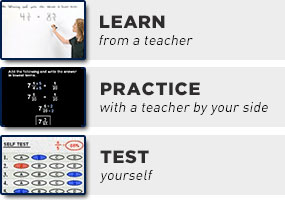Using Trig Identities to Evaluate Expressions
Purplemath
Why do you have to evaluate trig expressions with identities?
Only a few angles (such as 30° and 45°) are special, with easily-memorized exact trig values. To find exact values for some other angles, you have to apply trigonometric identities to convert those other angles into the special ones.
Content Continues Below
(In this context, "exact" means "the forms involving fractions and square roots, rather than decimal approximations").
Affiliate
Advertisement
Once you've learned some trig identities and the special angle values, you can use them to evaluate un-special angles in exact terms. Yes, you can always get a decimal approximation with your calculator, but it's good to learn the logic of using the identities, so you can exercise your skills at pattern-finding and pattern-matching.
How do you evaluate with trig identities?
To evaluate an expression by using a trigonometric identity, you first must find a way of restating the angle measure in terms of the special-angle measures. Then you apply the appropriate identity to restate the given expression in terms of the special-angle measures that you know. Finally, you simplify to get your answer value.
For instance, you may be asked to find the exact value of the sine of 15°. This angle is not one of the special angle values, but it is the difference of two special angle values; namely, the angles 45° and 30°. You can use the trig identity for the sine of a difference of angles, sin(A−B), to convert the expression to a form that contains just sines and cosines of special angles. From this, you can simplify to get the exact form of the sine's value.
(Fifteen is also half of thirty, and 30° is one of the special angles. So you could use the half-angle formula for sines, too. It will give you the same answer, and it is just as good as the angle-difference formula. Don't be surprised if you and a classmate have followed different paths to arrive at the same value.)
- Evaluate cos(75°) exactly.
I know the exact values for the cosine of 30° and 45°, and I see that 75° = 30° + 45°, so I'll use the angle-sum identity for cosine to compute this value "exactly":
You can check your answers to this sort of exercise by plugging each of the trig expression and the "exact" expression into your calculator. If the displayed values are the same (0.2588190451, in this case), then you know you've done the evaluation correctly.
- Evaluate tan(15°) exactly.
Since 15 = 45 − 30, I'll use the angle-difference identity for tangent:
This exercise can also be completed by using the half-angle identity for the tangent:
This solution was arrived at by using a different trigonometric identity, but the answer is still the same.
Content Continues Below
If your textbook prefers radians (or if you're working in both degrees and radians), you'll be asked to evaluate expressions like , which is the same angle as in the example above.
The sums and differences of angle measures can be a bit harder to recognize in radian form; for instance:
Two useful sums are:
If you work better with, or feel more comfortable with, degrees, then convert any radian-measure angles to degrees, find the sums and differences, and then convert them back to radians.
- Evaluate sin(120°) using a formula.
Since 120° is twice 60°, I'll use the double-angle formula for sine:
sin(2×60°) = 2sin(60°)cos(60°)
Since 60° is a basic reference angle, I can now finish the evaluation by plugging in the values I've memorized:
- Evaluate cos(22.5°) exactly.
Since 22.5 is half of 45, I'll use the half-angle identity for cosine:
Since 22.5° is in the first quadrant, then the cosine value is positive, so I'll take the "plus" square root for my answer:
- Find cos(2x) if and x is in the third quadrant.
Affiliate
From the sign on the sine, I can only tell that x must be in either QIII or else QIV. It is because of this amgiguity that they had to specify the quadrant for x.
By the Pythagorean Theorem, I can find the third side of the triangle (being the (adjacent) side) from the sine's ratio value of (opposite) over (hypotenuse):
132 = (−5)2 + (adj)2
169 = 25 + (adj)2
144 = (adj)2
So the adjacent side has a length of ±12. Since the angle x is in the third quadrant and the (adjacent) side lies along the horizontal axis, then the "length" of (adjacent) is −12.
Plugging into the double-angle formula, I get:
In this case, it happened to turn out that I didn't really need the quadrant information; the squaring and subtraction took care of the signs. But sometimes you will need to pick one of two values, as in the previous example. Don't get lazy with the "plus/minus" signs. Keep track of where you are and where you're going, and pick the appropriate sign, as needed.
URL: https://www.purplemath.com/modules/ideneval.htm
You can use the Mathway widget below to practice using trig identities to evaluate trig expressions. Try the entered exercise, or type in your own exercise. Then click the button and select "Expand Using Sum/Difference Formulas" (or some similar option) to compare your answer to Mathway's.
Please accept "preferences" cookies in order to enable this widget.
(Click "Tap to view steps" to be taken directly to the Mathway site for a paid upgrade.)
Select a Course Below
Standardized Test Prep
Homeschool Math
© 2024 Purplemath, Inc. All right reserved. Web Design by ![]()




